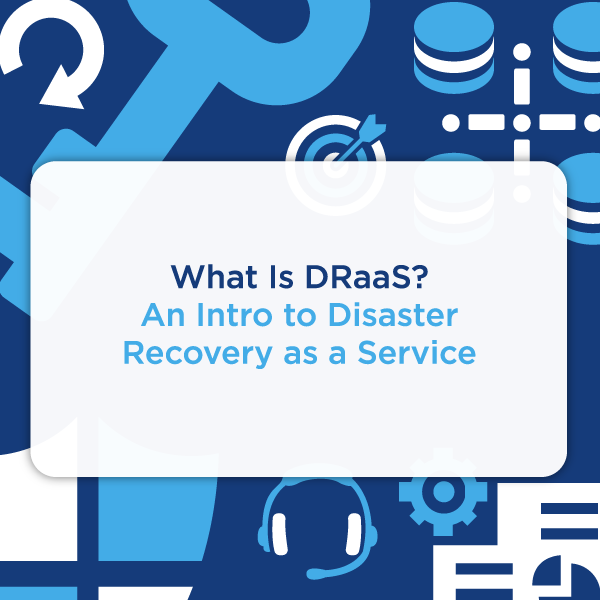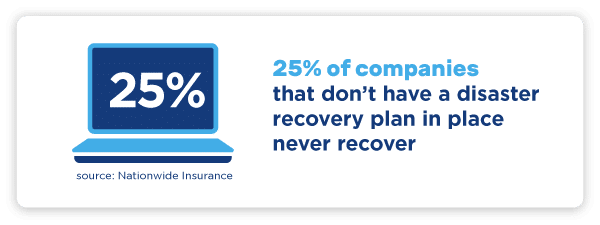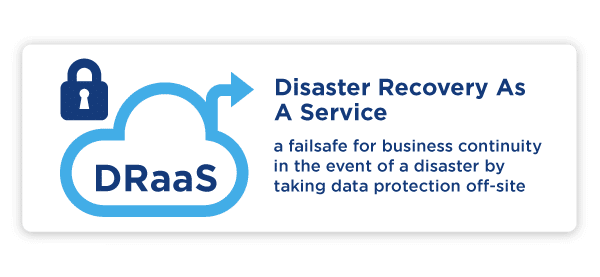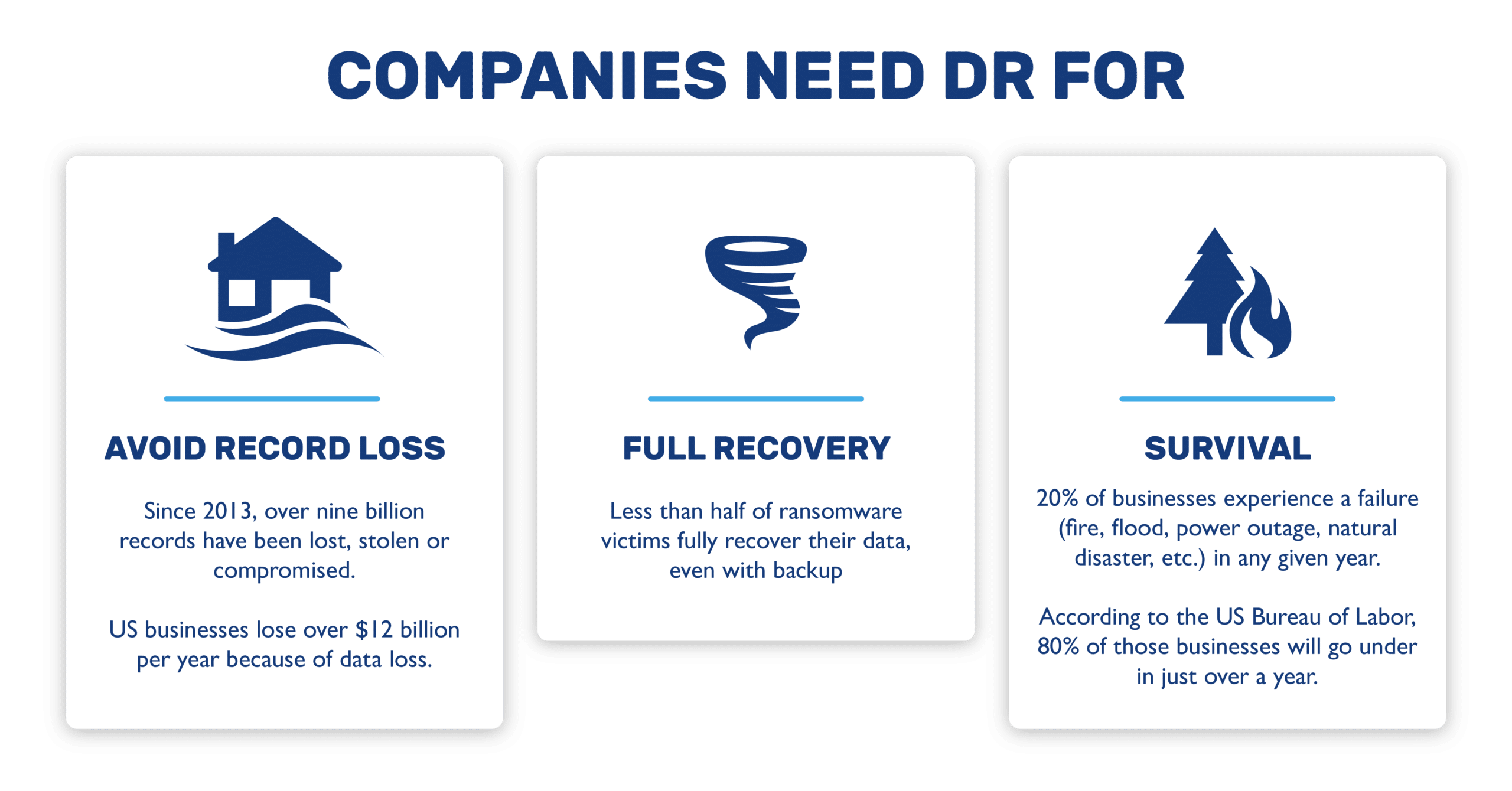What is DRaaS? An Intro to Disaster Recovery as a Service
Disaster recovery as a service (DRaaS) takes data protection off-site to help companies ensure business continuity in case a disaster strikes.
Businesses of all sizes are facing more data and cybersecurity risks than ever before. Large enterprises can afford to have extensive resources and teams on hand to mitigate risk, but most mid-size brands lack the resources for in-house, round the clock IT help to plan for disasters and business interruptions. IT staffers are focused on the everyday details that support business needs, not the threats you don’t see coming.
Because of this, today’s in-house IT teams are often strapped for time. This leads to an issue that you won’t discover until it is too late—a lack of disaster recovery planning. Many mid-sized businesses make this mistake, and for those who do encounter an emergency, the consequences can be devastating. Data protection companies that provide as-a-service technology offerings can lift the burden of disaster recovery from in-house teams by using Disaster Recovery as a Service (DRaaS) to help ensure business continuity in the face of a cyber attack, natural disaster, or human error.

In this article we’ll cover the risks of sticking with legacy backup, an overview of DRaaS, and tactical questions to consider before implementing it.
Table of Contents
- Challenges with Legacy Disaster Recovery
- What is DRaaS?
- 5 Ways DRaaS Benefits Your Business
- What to Consider before Implementing DRaaS
Challenges with Legacy Disaster Recovery
A Nationwide Insurance study found that 52% of business owners admit that disaster recovery can stretch as far as 90 days. However, 75% of these same owners do not currently have a plan for disaster recovery. Of this group that does not have a plan in place, 25% of them never recover from a serious disaster. Investing in DRaaS is far from just talk; it is now a quantifiable assertion.

It is no longer enough to have a disaster recovery plan sketched out on a napkin for your business. The upgrades in disaster recovery technology have fully separated modern solutions from their legacy counterparts. Legacy DR may leave backdoors wide open for malicious users or hackers to come through.
Traditional enterprise storage solutions such as configuring multiple sites for workload execution, or backing up to tape are going by the wayside because the per-hour cost of a business going down is so high that the risks outweigh the benefits.
Risks that Come with Legacy Disaster Recovery Solutions:
- Longer recovery time objectives (RTOs). This can affect day-to-day operations as well as long-term revenue and even your company reputation.
- High costs of DR capital. Legacy DR is hardware intensive, which requires a huge investment of time and money making cost a barrier for many companies.
- Threats to your proximity. Solutions that are on-site face the same risk of a disaster. Solutions that are off-site reduce your RTOs and increase the challenges you face with bandwidth.
Take a look at our disaster recovery checklist for a deeper comparison between legacy DR and DRaaS.
IT environments are becoming more diversified, meaning that a single failsafe solution or universal approach is often inadequate for today’s business environment. As DRaaS continues to advance in technology, flexibility and cost, companies will increase their adoption while phasing out legacy solutions.
What is Disaster Recovery as a Service?
Disaster recovery as a service creates a failsafe for business continuity by using an IT solutions company to take data protection off-site.

DRaaS allows for the automatic rebuilding of your network using proprietary software and methods. This captures a complete replica of your current data center in a secure location in the case that disaster strikes.
Since your data is safely stored entirely off-site, and someone else is managing the updates and data protection, your IT team can rest assured that data is safe while you manage your business. Data protection remains intact no matter what happens to your physical structure or local network. As soon as you get to a secure location, you’ll be able to re-access data and resume critical operations without delay or loss.
According to FEMA, an astounding 90% of small businesses fail in the year following a disaster if they experienced business closure for just five days. The reality of floods, storms, or cyberattacks lurking around the corner are all too real. When staring down the aftermath of disaster, don’t let data recovery be another concern. DRaaS ensures your business is up and running after facing system failure.

5 Ways DRaaS Benefits Your Business
Arguably the biggest benefit of DRaaS is ensuring business continuity in the event of a disaster, but this isn’t the only advantage. Benefits like predictable payments and mitigating ransomware have led DRaaS to an annual growth rate of 41.8% by 2022 according to Markets and Markets. Here are the top five advantages of DRaaS.
1. No More Testing or Monitoring the System
Disaster recovery systems kept on-site only work when they are fully ready, tested and monitored. When you opt for DRaaS, you move everything off-site, including all testing. This ensures that your disaster recovery is always available to you and that it will work when you need it most.
2. More Time for In-House Teams to Focus on Innovation
Implementing DRaaS means your in-house team can focus on the day-to-day tasks of running your network and keeping things working as they should. You’ll get the support of a team of trained professionals who are always up-to-date on evolving threats.
3. Scalable and Predictable Payments
A comprehensive in-house approach to disaster recovery will require the ongoing provision of more space and equipment. With legacy DR, you’ll have to invest in items and technology up front, even if you do not need that much protection right now. Compared with traditional disaster recovery, DRaaS is fully scalable and grows when you do. No more buying an entire system or space that’s much larger than you need.
Also, no dealing with outgrowing your protection technology. With DRaaS you pay as you go for what you need. This allows you to get full coverage and reduced risk at the lowest possible cost. Read this case study to see how ComportSecure helped a hospital afford a new MRI machine by modernizing its DR.
4. Guaranteed Failover
Business interruption is no longer a risk with guaranteed failover. Your team won’t have to struggle to get your entire network back online—and you won’t have to worry about the type of interruption that can take days or even weeks to address.
5. Mitigate Ransomware Attacks
New forms of ransomware make headlines every week—and no business is safe. Hospitals, law firms, retailers and more have all been targeted and locked out of their own systems for days at a time—until they hand over some cash. When you have DRaaS, the threat of ransomware (that you will not be able to access your data) is eliminated. Even if your organization is breached, you won’t need to pay the ransom to recover your network—you’ll simply work with the saved, up to date replica and proceed as usual.
Implementing DRaaS means reducing the burden of disaster recovery on your in-house team. This reduces their workload and ensures that critical functions are carried out as they should be.
What to Consider before Implementing DRaaS
You can always count on Murphy’s Law to affect your business, especially if you don’t have protection in place. Whatever can go wrong will go wrong, and you need a technology solutions company that understands and can react to this physical truth.
These three questions will help determine if a third-party IT provider is right for you as you explore DRaaS.
 What support exists to integrate DRaaS with our virtual and physical environment?
What support exists to integrate DRaaS with our virtual and physical environment?
Any DR solution that you seriously consider should be able to integrate fully with modern virtualization platforms such as Hyper-V from Microsoft or VMWare. Get started today with our VMware vSphere Optimization Assessment. DRaaS should also be able to integrate with your physical servers. In most cases, your businesses will be using hybrid solutions that include capabilities like hypervisor replication and high-level storage. These features help businesses optimize the infrastructure they already have instead of having to change the structure around the disaster recovery solution.
 What is your protocol for assessing DRaaS?
What is your protocol for assessing DRaaS?
Even the best disaster recovery solutions must have a robust assessment component in order to find and tweak weaknesses in the program. Disaster recovery testing should be able to easily occur within different environments without causing disruptions in day-to-day business.
This is important because all disaster recovery requires frequent assessments in order to maintain the veracity of backup and disaster recovery plans. Assessments also help businesses avoid unexpected, last-minute surprises. Lastly, a paper trail of assessments also helps a business to remain in compliance with BCDR audits.
 Do you allow customization of service level agreements for our business needs?
Do you allow customization of service level agreements for our business needs?
Disaster recovery service providers must be able to give end users the ability to define parameters including SLAs, RTOs and RPOs. They should also be able to regulate resources such as memory and processor allocation. The best solutions give all of these capabilities in an intuitive user interface that allows for failback and failover solutions irrespective of the infrastructure that the recovery is taking place in. Learn more about making a DRaaS implementation successful.
Disaster Recovery Solutions That Keep
The best disaster recovery strategy contains a level of resiliency that is simply not found in legacy DR solutions.
Whether your business is an SMB or international enterprise, data safety is always a top priority. Proper preparation in the modern business landscape is more than implementing enterprise cloud backup. It’s creating a plan for the worst case scenario. DRaaS is an essential part of risk mitigation planning—but it only helps you if you have it in place when disaster strikes. Request a DRaaS Assessment to determine your readiness today.




























